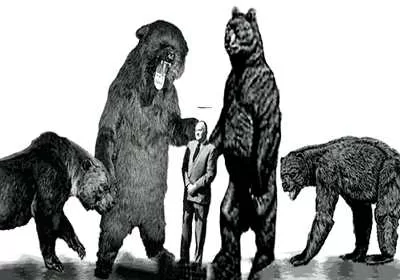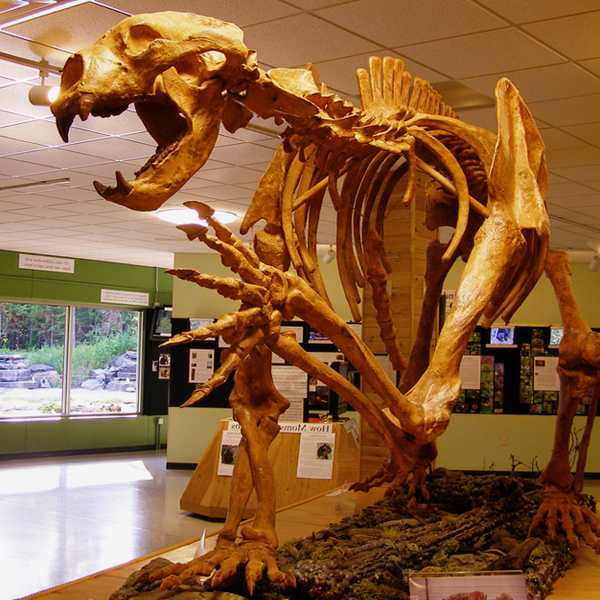When the first humans crossed the Bering Strait into North America, they stepped into a world brimming with colossal creatures. The landscape was a hunter’s paradise, teeming with mammoths, mastodons, and giant sloths. But alongside these majestic beasts prowled some of the most formidable predators ever to walk the Earth.
Among these fearsome creatures was the dire wolf, a larger and bulkier relative of today’s gray wolf. The saber-toothed and scimitar cats, with their massive canines, could inflict devastating wounds. The American lion, an even larger cousin of the African lion, roamed the land, while the short-faced bear, Arctodus simus, stood as the ultimate terror.
Arctodus simus, estimated to weigh between 700 and 800 kilograms (1,543 to 1,763 pounds), was the largest carnivorous mammal ever to inhabit North America. For decades, scientists debated whether this colossal bear was a fearsome predator or merely a scavenger with a diverse diet.
Björn Kurtén’s Vision of the Short-Faced Bear
In the 1960s, the late Finnish paleontologist Björn Kurtén, a leading expert on Ice Age mammals, argued that Arctodus simus was a hypercarnivore. Kurtén highlighted the bear’s short, broad snout, robust jaws, well-developed carnassials (teeth adapted for cutting meat), and long limbs. He painted a picture of a giant bear capable of running down prey, making it the ultimate nightmare for early human settlers.
Kurtén’s interpretation was based on the physical characteristics of the bear and the comparison of its traits with modern predators. The idea of a powerful, predatory giant bear captured the imagination and contributed to its reputation as one of the most terrifying Ice Age creatures.
Challenging Kurtén’s Hypothesis
However, not all paleontologists agreed with Kurtén’s conclusions. Critics pointed to several factors that suggested Arctodus simus might have been less of a relentless predator and more of an omnivore or scavenger. They noted similarities between Arctodus simus and the South American spectacled bear, which is primarily herbivorous. Some suggested that the short-faced bear might have consumed a substantial amount of plant matter and scavenged from carcasses.
A recent study by researchers from the Universidad de Málaga in Spain sought to reassess these competing claims. Their investigation involved several key aspects of Arctodus simus’s biology and ecology.

New Insights into Arctodus Simus
The Spanish team began by examining the body mass of Arctodus simus. They found a wide range of estimates, from about 300 kilograms (660 pounds) to nearly one ton (2,200 pounds). This variability included geographic differences, with larger individuals coming from northern regions, akin to the size variation observed in modern brown bears.
Next, the researchers analyzed the skull and limb proportions of Arctodus simus. Contrary to earlier beliefs, the bear did not have an exceptionally short snout, and its skull proportions were consistent with its size. They also noted that the most carnivorous living bear, the polar bear, possesses a relatively long snout, suggesting that Arctodus simus’s snout length was not a definitive indicator of its dietary habits.
The study also found that while the forelegs of Arctodus simus were enlarged, its hind legs were not proportionately longer than those of present-day bears. This finding implied that Arctodus simus was not built for running but was more likely adapted for other forms of locomotion.
Reassessing the Bear’s Diet
Despite the revised view of its physical capabilities, the new study did not completely exonerate Arctodus simus from being a meat-eater. Analysis of the carbon and nitrogen isotope ratios in its bones suggested that the bear did consume some meat. This indicates that while it was not the relentless predator once imagined, it likely had a varied diet that included both plant and animal matter.
Modern grizzly bears, for instance, consume a significant amount of vegetation but occasionally hunt large prey like elk or even fend off wolves from their kills. It’s plausible that Arctodus simus displayed similar behaviors, leveraging its massive size to dominate its environment and occasionally scavenge or hunt.
Legacy of the Short-Faced Bear
The awe-inspiring presence of Arctodus simus remains a testament to the grandeur and complexity of Ice Age fauna. While it may not have been the predatory giant once envisioned, it was undoubtedly a magnificent creature, showcasing the diverse evolutionary paths of ancient mammals.
The extinction of Arctodus simus, along with the rest of North America’s Ice Age megafauna, occurred around 11,000 years ago. This extinction marked the end of an era for these colossal creatures and left behind a legacy of fascinating, and often chilling, stories.
Today, the short-faced bear stands as a symbol of a time when North America was home to some of the most remarkable and intimidating wildlife ever known. For those who study the ancient past, it serves as a reminder of the dynamic and ever-evolving nature of life on Earth.
In summary, while Arctodus simus may no longer reign as North America’s top predator, its role as a formidable and versatile giant continues to captivate the imagination. The study of this magnificent bear enriches our understanding of Ice Age ecosystems and the creatures that once dominated them.

